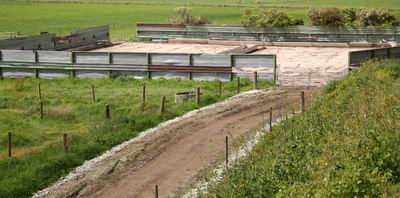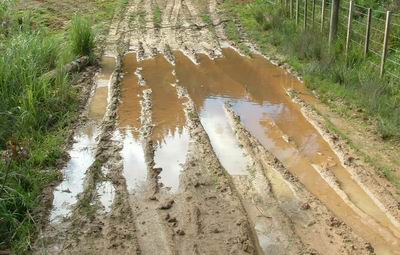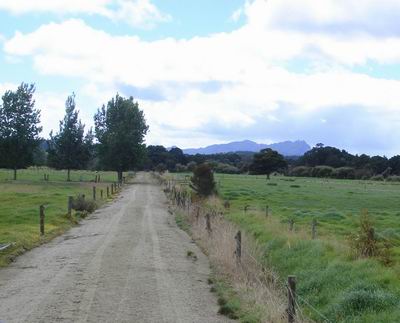Building and maintaining farm tracks
Why are good tracks important?
Tracks, races and accessways are crucial for getting around farms and rural properties.
Having the right tracks for the job will minimise maintenance requirements and help day-to-day operations to run smoothly.
Many of the farm tracks in use today were designed for less intensive farming systems. Herds were much smaller and most tracks weren't originally intended for heavy vehicle use so they are often too narrow, poorly drained and require a great deal of maintenance.
Having stable, safe, effective tracks should be a key priority for any landowner.
The rules
You generally don't need resource consent to construct farm tracks, races and access ways on your land (except in the riparian management zone or if you are moving more than 5000m3 of earth in non erosion-prone land or 1000m3 in erosion-prone land within a 12 month period) but there are some regional rules that you're required to follow.
-
All practical measures must be taken to avoid creating erosion and disturbing vegetation (side castings from digging or grading can find their way into waterways and worsen flooding).
-
The race must not allow agrichemicals to get into water courses. These chemicals can bind onto silt and sediment particles and washed into waterways during rain, causing pollution and reducing water quality.
-
Care must be taken not to interfere with sites of cultural significance, such as pā sites, urupa (cemeteries) and any early European buildings or structures.
-
Earthworks can't be done in wetlands or influence water levels that affect wetlands.
If in doubt, contact a Northland Regional Council land management adviser to discuss your plans.
Building farm tracks
 Building a good accessway takes good planning.
Building a good accessway takes good planning.
A well-built farm track will provide a surface that gives good foot and wheel traction in a range of weather conditions.
Farm tracks should be based on sound construction principles and allow for planned expansion of stock numbers and vehicles.
The type of track you build depends on what it will be used for – a track for the quad bike to access the back of the farm will be different than a forestry block access road which needs to support heavy, multi-axle vehicles.
Deciding on the primary use for your track and tailoring construction accordingly are important first steps.
Principles of building good farm tracks
-
Whatever type track you need, there are some key principles to follow for building good tracks:
-
Remove grass and topsoil
-
Build a sound base
-
Compact the surface well
-
Use suitable surface material, i.e. metal
-
Crown the race – make sure it slopes off to the sides and is high in the middle
-
Build drains along the side.
Know your soil types
Some Northland soils are more erosion-prone than others – it pays to know what type of soil you're dealing with before you start building.
You can talk to one of the council's land management advisers for information on soils and rock types.
Drainage
Drainage is vital when you're planning a farm track. If there's no drainage, a track is unlikely to stand up to wear and tear. To create good drainage:
-
Build drains along both sides of the track to prevent water seeping into the base from the surrounding ground. The drains must have the correct grade and the water needs somewhere to flow – preferably to an area of stable land (a wetland is a possibility).
-
Fence off drains to avoid damage from stock. A single-wire electric fence will work as a minimum.
-
Put in a culvert where a track crosses a small watercourse or where water needs to be drained under the laneway (this is a requirement). Culverts of 300mm diameter are good for most situations.
-
Wherever possible, ensure the water table is at least 600mm below the track surface. The higher the track above the water table, the better, as this will allow it to be used in a range of conditions.
 Poor drainage makes farm tracks inaccessible during wet weather and creates run-off into waterways.
Poor drainage makes farm tracks inaccessible during wet weather and creates run-off into waterways.
Maintaining tracks
Once built, tracks should be maintained as required – building them the right way will save money on maintenance in the long run.
Even a well constructed farm track needs regular maintenance if it's to continue to function effectively. Cows often cause a build-up of manure and track debris along the edge of tracks – which prevents water draining away – so running over the race once a year with a grader blade will remove blockages and improve flows.
 A well built farm track will save on maintenance in the long run.
A well built farm track will save on maintenance in the long run.
More information
Our land management advisers can provide free advice on building safe, effective tracks that are suited to your land and your needs.
For more information please contact a Northland Regional Council land management adviser on 0800 002 004.
Also check the New Zealand Forest Owners Association's manual on forest road engineering – see www.nzfoa.org.nz
Thanks to the following statutory authorities for providing information for this fact sheet: Waikato Regional Council, Taranaki Regional Council, Bay of Plenty Regional Council, Ministry for the Environment.
